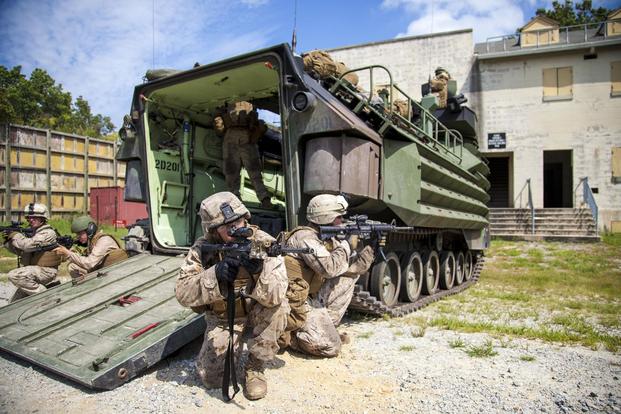Commanders could soon give Marines the OK to wear body armor that weighs up to 40 percent less than their current plates as the Corps seeks out new protective options for differing missions.
Marine Corps leaders will meet with industry experts this month to talk about what they're looking for in a new LITE plate, one designed for a low-intensity threat environment, said Nick Pierce, the individual-armor team lead with Marine Corps Systems Command. The service could start buying the new body armor as early as next fall.
"It won't replace the current plates," Pierce said, "but it can be used when the commanders choose -- when the threat warrants this lighter plate."
An August request for information put out by the Marine Corps stated that the plate should "provide two-shot ballistic protection from non-armor-piercing rounds that are currently prevalent in counter-insurgency operations and other low-intensity threat environments."
Related content:
- Marines Award $62M Contract for Lighter, Stronger Plate Carriers
- Marines to Ramp Up Tests on Hearing Protection Troops Might Actually Wear
- Army Body Armor May Be Too Heavy for Combat, Report Finds
That includes rounds fired by sniper rifles from about 110 to 220 yards away, according to the request.
Exactly what types of rounds the new armor should be able to stop is classified, said Barb Hamby, a spokeswoman for Marine Corps Systems Command. Marines' current body armor, the Enhanced Small-Arms Protective Insert, is designed for the worst-case scenarios, Pierce said.
"We're trying to design and field a plate that will protect against the preponderance of threats in most of the environments we go into," he said. "When we focus on the preponderance of threats for the low-intensity conflict areas, we can reduce the weight quite a bit -- we're thinking 35 to 40 percent weight reduction."
That could shave about 5 or 6 pounds from the weight Marines currently carry.
"Right now, commanders don't really get a choice," Pierce said. "You either go with the big heavy plate that can do anything you want anywhere or you can go with no plate."
Marines recently tested a lighter plate along with the next-generation plate carrier on a mobility course. Those Marines were able to move 8 percent faster, Pierce said. Increased speeds can help save lives on the battlefield, he said, just as armor can.
Giving commanders options helps them make decisions in combat that could help cut down on fatigue or heat casualties, he added. "The commander's balancing the trade-off between the risk all across the spectrum: the risk of not being able to move fast enough; the risk of impacts coming toward your Marines; heat, fatigue, all those things."
Marine leaders can expect members of Congress to pay attention to the weight and effectiveness of the new plates. In 2013, a congressional committee ordered the Pentagon to find ways to reduce the heavy weight of body armor. But safety and survivability remain top priorities.
Companies that might be able to produce the lighter armor will have the chance to read the Marine Corps' draft solicitation ahead of the Oct. 18 meeting. The service's final solicitation is expected to be released in November.
-- Gina Harkins can be reached at gina.harkins@military.com. Follow her on Twitter at @ginaaharkins.










